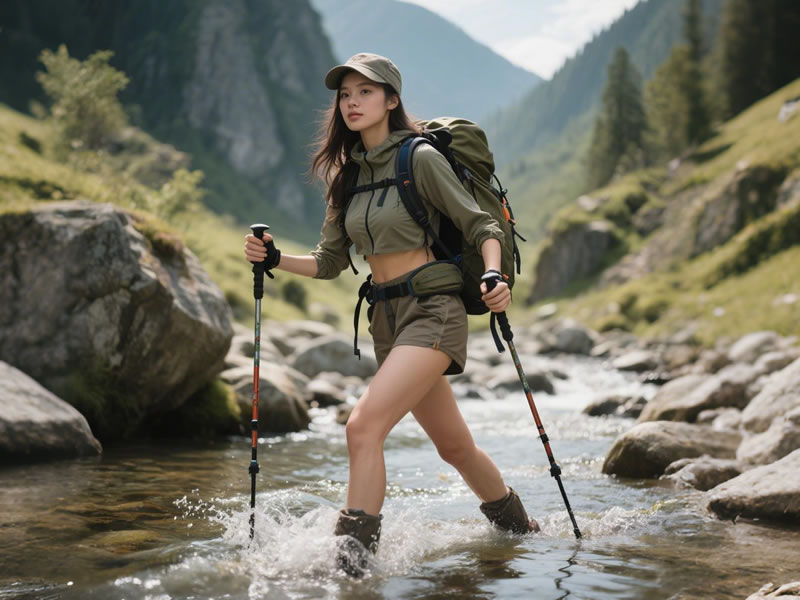How to use trekking poles for river crossings while hiking?
# How to Use Trekking Poles for River Crossings While Hiking
When hiking, river crossings can be both thrilling and risky. Properly using trekking poles can transform these challenges into safe, manageable obstacles. This guide breaks down essential techniques to maximize your poles' stability and safety, optimized for hikers of all levels.

1. Choose the Right Trekking Poles for Water Crossings
Not all poles are created equal. 优先选择具有 adjustable height(可调节高度)and non-slip tungsten carbide tips(防滑碳化钨杖尖)的型号,as they provide better grip on wet rocks. Two poles are ideal for river crossings—they create a triangular base of support, significantly improving balance compared to a single pole. Look for lightweight, durable materials like carbon fiber or aluminum to reduce fatigue during long hikes.
2. Optimize Pole Height Before Entering the Water
Start by adjusting your poles to shoulder height when standing upright. This length ensures you can plant them firmly without overreaching. A quick test: with elbows bent at 90 degrees, the handles should rest comfortably in your palms. For deeper water or stronger currents, slightly extend the poles to maintain a stable posture (no more than 2-3 inches above shoulder height to avoid instability).
3. Master the Proper Grip and Stance
- Grip firmly but relaxed: Hold the poles with a slight bend in your elbows, allowing natural movement while maintaining control.
- Face upstream: Position your body to face the current, reducing the risk of being swept off balance. Angle your torso slightly forward, using the poles as outriggers.
- Create a wide base: Place the poles 12-18 inches apart in front of you, forming a "tripod" with your feet. This distributes weight evenly and resists lateral force from the water.
4. Probe the Riverbed Strategically
Before taking a step, use your poles to test water depth and substrate:
- Tap the riverbed gently 1-2 feet ahead of your intended path to detect loose gravel, slippery rocks, or hidden holes.
- Look for eddy currents (calmer, circular flows) near the shore—these often indicate shallower, more stable footing.
- In murky water, use a sweeping motion to map the terrain: a solid "thud" signals a rock; a soft sink indicates mud or sand (avoid these areas if possible).
5. Navigate Currents with Pole Angling
Adjust pole angle based on water speed:
- Slow-moving water: Hold poles vertically, using them primarily for balance as you shuffle forward with small steps.
- Faster currents: Tilt poles 30-45 degrees upstream (tips pointing downstream), creating a brace against the flow. Press the poles into the riverbed to anchor yourself before transferring weight to your next step.
- Deep crossings: Use a "paddle-and-plant" technique—push the poles against the current to generate counterforce, then plant them firmly before moving your foot.
6. Maintain Balance and Momentum
- Take short, deliberate steps, never extending your leg more than 12 inches ahead. Transfer weight slowly from one foot to the other, using the poles to steady yourself during the shift.
- If you feel a slip, lean into the poles immediately—their rigidity can prevent a fall. Avoid sudden movements; steady pressure is key to maintaining grip.
- For uneven terrain, use one pole to probe while the other stabilizes, alternating as you progress.
7. Post-Crossing Safety Checks
Once on dry land:
- Inspect poles: Remove debris (moss, gravel) from the tips and joints to ensure they function properly for the next use.
- Readjust height: Shorten poles back to your normal hiking length to avoid tripping on uneven trails.
- Dry grip handles: If wet, use a quick-dry cloth to prevent blisters from prolonged moisture contact.
Pro Tips for Safe River Crossings
- Hike with a partner: Use the "buddy system"—one person crosses while the other waits, ready to assist if needed.
- Time your crossing: Avoid high water levels after rain; check local forecasts or trail reports for river conditions.
- Practice on dry land first: Master pole techniques on rocky trails before attempting fast-moving water.
Common Mistakes to Avoid
- ❌ Overextending poles: Too much height reduces control and increases the risk of tipping.
- ❌ Ignoring current direction: Facing downstream makes you vulnerable to being knocked off balance.
- ❌ Rushing steps: Hasty movements disrupt your center of gravity—slow, steady progress is safer.
Conclusion
Trekking poles are more than just hiking accessories; they're essential tools for navigating river crossings safely. By adjusting height, mastering grip and angling, and probing strategically, you'll turn challenging water crossings into confident, secure steps. Remember: preparation and technique outweigh strength—even novice hikers can tackle rivers with the right approach.
Ready to hit the trails? Share your river crossing tips in the comments, and don't forget to tag your adventure photos with #TrekkingPoleTips #RiverCrossingSafety. Stay safe and happy hiking!






